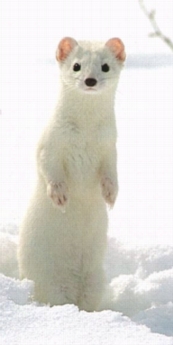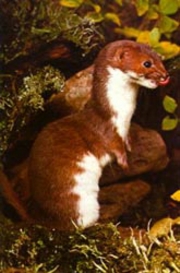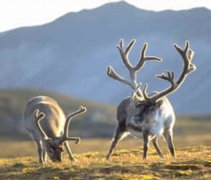*All prey listings are here, the first 3 are for 1 person catches, the rest are for pack catches as one wolf cannot hunt a deer or something*
--
ErmineCommon Names: Short-tailed Weasel, Stout, Royskatt
Genus: Mustela
Species: erminea


The ermine is found all over Canada, northern USA, and Eurasia. The Ermine lives in northern biomes such as taigas and tundras. The Siberian tundra is a vast land that is almost completely dark during the winter season because of its far north location. Also, the climate in winter is extremely cold. In fact, the Siberian Tundra is the coldest biome in the world. In the summer the Siberian tundra has many bogs and puddles scattered around the land because permafrost won't let the winter snow drain off. It is during the summer that most of the animals come out. Although the climate remains fairly cold, the Siberian Tundra is bright with sunshine. Ermines like to inhabit marshes, open spaces or rocky areas next to woodlands. The ermine is well adapted to living in this harsh environment. They make their dens in the old roots of a tree or in the crevice of a rock. Ermines are capable of having several dens.
Ermines may make their dens in the roots of trees farther south, but there are no trees on the tundra.
The ermine is a small animal that weighs between 3 - 15 ounces. The head and body length can range from 7 - 13 inches and the tail can grow up to 5 inches. The males are much longer than the females. In the spring and summer the ermine's coat is chocolate brown with a white underbelly and a black tip on the tail. In the winter the coat turns entirely white except for the black end of its tail. The ermine's flexible spine allows it to do the "marten run" in which the hind feet are tucked in by the front feet, causing the back to arch, and then extended. Since the ermine is a carnivore, it has 34 sharp teeth. It has short legs and a long body and neck. The head is triangular shaped with small round ears, small, bright eyes and long whiskers.
The male ermine reaches maturity at 12 months. The female reaches maturity at 2 months of age. The mating season is during late spring and summer. They have babies every year. Three to thirteen young are born each mating season. The birth size of the ermine is a half an ounce. When the kits [babies] are 8 weeks old their mother teaches them to how to hunt. After the mother teaches them how to hunt the female kits [babies] are ready to mate. The males aren't ready to mate and leave their mothers the next spring. The females might stay under their mother's protection in her territory. Ermines are very territorial. The female ermine has the sole responsibility of raising the young. The males do not usually help raise the young. An Ermine's life span is 4 to 7 years. Aside from raising young, the ermine is a solitary animal.
The ermine is a carnivore and eats rabbits, small insects and rodents. Because of their sharp teeth they are able to catch animals larger than themselves. In different habitats ermines will eat birds or amphibians. It will also eat most small mammals. When the ground is covered with snow the ermine will hunt entirely under the snow for small rodents.
Their ermine paws have claws which enables it to dig. The front feet are smaller than the back which helps it fit into small, tight spaces. The coat of the ermine changes with the seasons and camouflages it from predators. In winter the ermine's coat is white blending in with the snowy environment. In warmer seasons the fur turns brown again matching the color of the landscape.
In its Siberian tundra habitat ermines prey on a range of small animals and birds. In a different environment ermines are know to sneak into barns for a meal of chicken eggs. They are very adaptable in their diet depending on where they live. In their Siberian environment the ermine is prey to snowy owls, arctic foxes, lynx, gyrfalcons, hawks and other large mammals and birds of prey.
When it starts to get colder in Autumn the ermine sheds its brown coat it wore in spring and summer, and grows a new white coat for winter camouflage. A long time ago during the Middle Ages the fur of the white phase of the Ermine was popular in clothing. Now ermines are almost never used in clothing. Ermines are neither threatened or endangered.
Arctic Hare (Lepus arcticus & othus)

The arctic hare is not the same thing as a snowshoe hare. It is not even the same as a rabbit. There are two hare that live in Arctic areas - they are the arctic hare and the tundra hare. The major difference between them is where they live, and the color their tail turns. The arctic hare is larger than a snowshoe. His fur is long and white all the way through in the winter and his ears are blackish around the edges. In the summer his coat is grayish brown on top and white beneath.
Size: 22-28 in.
Weight: 9-12 lb.
Color: Brown in the summer, white in the winter. Ears tipped with black year round.
Distinguishing Characteristics: Short ears, and a fur coat that changes color with the seasons make the arctic and tundra hare special. Leverets born June thru July. Usually there are 4-8 in a litter. They are fully furred and have their eyes open. Lepus articus live in Canada and Greenland. Lepus othus lives only in Alaska. The arctic hare likes to live on the rocky slopes and upland tundra of the Arctic. They like to live in groups. They don't like to live in low places or wooded areas. The food they eat is mostly willow - the leaves, shoots, bark and roots - and grasses, flowers, saxifrage and crowberry.
Arctic Tern(Sterna paradisaea)

The arctic tern is a relatively small bird. It is also one of the most determined. Even though it is small it is still able to accomplish the remarkable feat of migrating over 22,000 miles (35,000 km) each year. The distance that it migrates is the longest of any bird. This mileage would be accurate if it flew in a straight line to where it was migrating to and from. But since it takes a lot of excursions the distance it flies each year is even greater. In fact the arctic tern almost never lands and is known to be in daylight more than dark because of its migration schedule.
Length: 12-15 in.
Weight: Under 2 lb. approximately
Color: White with a black head and a bright orange beak.
Black markings under each wing and its bright orange beak make the arctic tern stand out among other birds. Breeding: Breeds north of the 50th parallel. It lays clutches of one to three eggs. It takes 20 to 24 days to incubate the eggs. Eggs are laid in grassy areas for protection from their predators and also because there are no trees in the Arctic. The entire northern hemisphere Arctic area. It is a circumpolar animal. Small fish, shrimp, krill, or insects and small invertebrates.
PACK CATCHES OR MULTIPLE WOLF CATCHES:
CaribouCommon Names: Caribou, Reindeer
Genus: Rangifer
Species: tarandus

The caribou lives in the arctic tundra, mountain tundra, and northern forests of North America, Greenland, Scandinavia, and Russia. It is estimated that there are about 5 million caribou in the world. They were first domesticated in Norway and northern Asia and known as reindeer. People used them to pull their sleds, provide milk, meat and skins to build their tents. When it was seen how valuable they were, they were brought to Alaska in 1887. Later they were brought to parts of Canada. These North American
reindeer became known as caribou. Although they are called by different names, they are both considered to be a single species.
The caribou is actually a large members of the deer family. Unlike deer, both the male and female have antlers. The antlers of the male are long, branched and massive, and they are a little flattened at the ends. The antlers of the female are much shorter, simpler and more slender and irregular. Sometimes they are completely missing.
The caribou is a sturdy animal with short legs. Its coat is brown and becomes darker in the summer and lighter in the winter. It has a ruff of long hairs under the neck, and the fur above the hooves and around the tail are almost white. The Alaskan caribou is clove-brown with a white neck and hindquarters.
Adult bulls average 350-400 pounds, but can weigh as much as 700 pounds. Mature females average 175-225 pounds They can range anywhere from 34 to 55 in height at the shoulder.
They are well adapted to living on the tundra. Their large, spreading hooves support the animal in snow in the winter and marshy tundra in the summer. Caribou are also great swimmers and use their feet as paddles. They can also lower their metabolic rate and go into a semi-hibernation when conditions get very harsh.
When it looks like there is nothing to eat on the winter tundra, caribou will scrape the snow away with their wide feet or antlers and eat lichens, dried sedges and small shrubs. In the summer they the will eat leaves of willows, sedges, flowering tundra plants, and mushrooms.
Caribou are social animals and live in huge herds. Males are often loners, until its time to mate, which begins in late September and October. The herds will often have several thousand animals in it. They will migrate more than 400-500 miles to reach winter or summer feeding grounds, and can travel up to 50 miles a day. The caribou's leg tendons make crackling sounds when it walks, which would make a migrating herd an noisy bunch indeed.
Pregnant females will lead the migration to the calving grounds in May, where they will give birth to a single calf. Most females don't breed until they are 28 months old, and will give birth every year. They weigh an average of 13 pounds and grow very quickly, doubling their weight in 10-15 days. Their hair is a reddish-brown. Newborns can walk within an hour and in a few days can run with the herd. Still, wolves, grizzly bears, and golden eagles kill a large number of newborn calves.